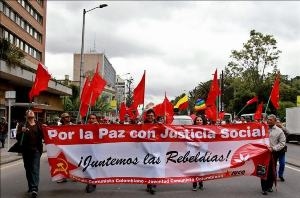Colombia’s stubborn insurgencies are creeping out of the jungle and to the negotiating table. Against the backdrop of recent intense fighting, the government of Colombia and the largest insurgent group that seeks to topple it — the FARC — have agreed to begin negotiations to end the nearly 50-year old conflict. They will begin talks in Oslo on Oct. 17.
The discussions will be hard enough in the absence of a cease-fire. They won’t be made any easier by the challenging issues on the agenda. If the government of Colombia and the FARC — the Revolutionary Armed Forces of Colombia — are to make headway, they’re going to have to tackle the ever-difficult issue at the top of the list: land reform. It is not only key to resolving the conflict, it is also, in the words of Colombia’s President Juan Manuel Santos, the cornerstone of efforts to “seed peace.”
Land reform was intractable at the time when the FARC began their struggle in 1964, and it remains a vexing issue today. Colombian society is still plagued by severe economic inequality, insecurity and grievances.
President Santos took the first steps toward remedying these issues in 2011 with the Victims and Land Restitution Law — a vast land titling and redistribution program. Showing his support, President Obama participated in a land-titling ceremony with an Afro-Colombian community during the recent Summit of the Americas.
But will the Victims Law be enough? Hewing to its socialist goals, the FARC is calling for “integral agrarian development.” The demands include increased access to land, the formalization of land rights, and the provision of inputs and credit to increase land productivity for small farmers. These demands reach far beyond the government reforms. Whereas the Victims Law anticipates 300,000 beneficiaries, the most recent census indicates that roughly one million households have tenuous property rights.
Our research suggests that the FARC and other interested parties are right to be concerned: Prior land distribution and titling efforts were captured by political elites who watered down the reforms. To convince the FARC to lay down its arms and to ensure that another insurgency doesn’t replace it, the government must demonstrate how it will implement additional reforms in the future.
This is no simple task. Complicating matters is the fractured nature of the conflict and the groups involved. The FARC is not only an advocate for reform, but also, along with other paramilitary groups, a culprit in forcibly displacing farmers from their land. New right-wing criminal bands and related “anti-restitution armies” have already begun targeting land advocates.
In the face of these challenges, the government should pursue a two-pronged strategy.
First, it should continue to press its offensive against criminal bands and other groups that violate human rights.
Second, it should encourage associations of victims and potential land recipients to voice their interests at the bargaining table, and it should be prepared to give these groups institutionalized participation in politics. Only then will peasants and other rural workers have the capacity to press for inclusion in the formal economy.
Better access to markets and government development programs will help remove one of the key reasons why some small farmers have resorted to cultivating coca or supporting the FARC. Institutionalized participation will also ensure that their political power does not evaporate when the next president comes to office.
Many Colombians are wary of the negotiations after past disappointments. But for the first time in decades they also feel there is a real promise for peace. Land reform now has broad-based support in government and commitment from the president, and the bureaucratic capacity for reform is higher due to the Victims Law. The FARC has also been weakened, and Colombian security forces are pursuing criminal bands with increasing vigor.
The outcome of the negotiations has implications well beyond its borders. Land conflicts contribute to civil strife around the globe, as demonstrated in the Philippines, Afghanistan and other countries. Serious efforts to negotiate reform and a credible implementation plan can serve as a model for dealing with the underlying grievances that motivate support for insurgencies. It is little wonder why so many are paying close attention to the negotiations.
Source: New York Times

